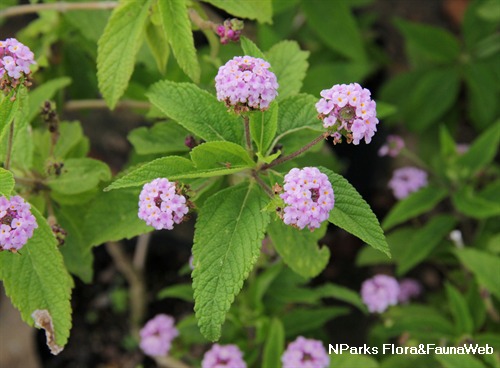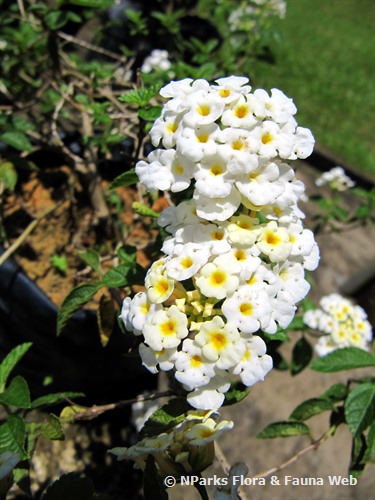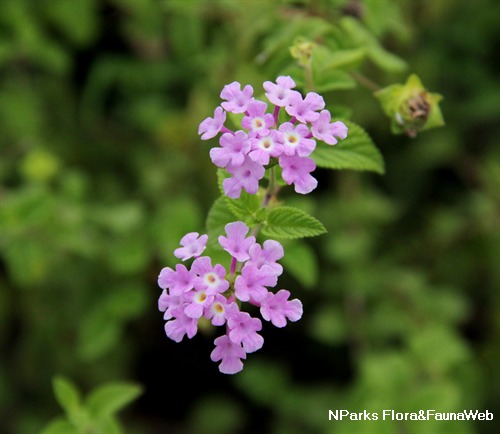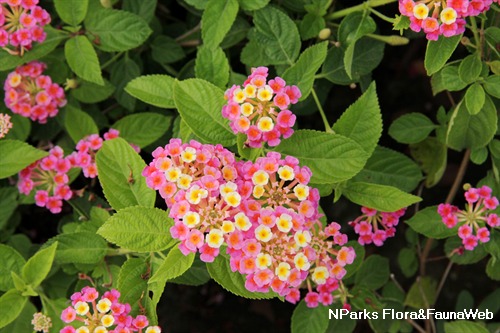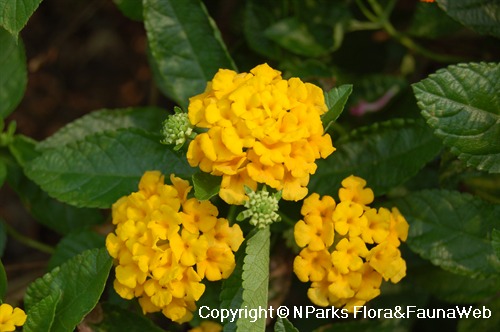
Name
Classifications and Characteristics
| Plant Division | Angiosperms (Flowering Seed Plants) (Dicotyledon) |
|---|---|
| Plant Growth Form | Herbaceous Plant |
| Lifespan (in Singapore) | Perennial |
| Mode of Nutrition | Autotrophic |
| Maximum Height | 0.3 m to 0.6 m |
Biogeography
| Native Habitat | Terrestrial |
|---|---|
| Preferred Climate Zone | Tropical |
| Local Conservation Status | Non-native |
Description and Ethnobotany
| Growth Form | Evergreen herbaceous to semi-woody plant with a prostrate growth habit. |
|---|---|
| Foliage | Opposite, aromatic leaves are narrowly ovate to ovate with serrate leaf margin (2.5 cm long). Leaves are deeply veined with a rugose surface that is covered in rough, irritating hairs. |
| Flowers | Salverform flowers are yellow. Flowers are arranged in rounded clusters known as umbels (2.5 - 3.8 cm wide). Plants are free flowering in the tropics. |
| Fruit | Fleshy, pitted fruits known as drupes are initially bluish green and then darken to purplish black. The seeds are typically not viable, because 95% of its pollen is sterile. |
| Cultivation | This cultivar is easy-to-grow and has a fast growth rate. It should be planted in well-draining, acidic to neutral soils that are sandy or loamy. After establishment, it will tolerate drought, heat and pollution. It will flower best under full sun. The green, unripe fruits are toxic upon ingestion, so it is best to prevent fruiting by promptly removing spent flowers. This cultivar can grow aggressively, so restrain its growth with regular pruning or pot it in a large container. Potted plants will flower better if they are allowed to become slightly rootbound. If whiteflies become a problem, spray the upper and lower leaf surfaces with a pesticide containing neem or pyrethrum. It is also susceptible to scale insects and leaf chewing insects. |
| Ethnobotanical Uses | Others: It can be planted to prevent soil erosion. |
Landscaping Features
| Landscaping | This cultivar is planted for its abundant, bright yellow flowers. Consider using this creeping cultivar as a groundcover or border. It would be attractive in a rock or butterfly garden. It is suitable for container plantings, such as hanging baskets or flower pots. This cultivar is an excellent choice for water-conscious gardeners, as it is highly drought tolerant. It is also tolerant of pollution and could be used to brighten roadsides. Although it is often advertised as non-invasive and sterile, it should not be planted in countries with wild populations of Lantana camara, because its pollen can successfully fertilize wild Lantana camara, introducing genetic diversity to the wild population. However, it can be safely planted in urbanized Singapore. |
|---|---|
| Desirable Plant Features | Ornamental Flowers, Fragrant (Flowers) |
| Landscape Uses | General, Flowerbed / Border, Suitable for Hanging Baskets, Container Planting, Coastal |
| Thematic Landscaping | Golden Garden, Butterfly Garden |
| Usage Hazard - Cons Remarks | Consumption of leaves may cause liver damage in dogs. Touching the leaves may irritate the skin. |
Fauna, Pollination and Dispersal
| Fauna Pollination Dispersal Associated Fauna | Butterfly-Attracting |
|---|---|
| Pollination Method(s) | Biotic (Fauna) (Insects (Butterfly, Moth)) |
Plant Care and Propagation
| Light Preference | Full Sun |
|---|---|
| Water Preference | Moderate Water |
| Plant Growth Rate | Fast |
| Rootzone Tolerance | Fertile Loamy Soils, Well-Drained Soils, Poor Infertile Soils, Saline Soils / Salt Spray, Acidic (low pH) Soils, Drought Tolerant |
| Maintenance Requirements | Low |
| Diseases | whiteflies, scale insects |
| Propagation Method | Stem Cutting |
Foliar
| Foliage Retention | Evergreen |
|---|---|
| Mature Foliage Colour(s) | Green |
| Mature Foliage Texture(s) | Hairy / Hirsute |
| Prominent Young Flush Colour(s) | Green |
| Young Flush Texture(s) | Hairy / Hirsute |
| Foliar Type | Simple / Unifoliate |
| Foliar Arrangement Along Stem | Opposite |
| Foliar Attachment to Stem | Petiolate |
| Foliar Shape(s) | Non-Palm Foliage (Ovate) |
| Foliar Venation | Pinnate / Net |
| Foliar Margin | Serrate / Toothed |
| Foliar Apex - Tip | Acute |
| Foliar Base | Rounded / Obtuse |
| Leaf Area Index (LAI) for Green Plot Ratio | 4.5 (Shrub & Groundcover - Dicot) |
Non - Foliar and Storage
| Stem Type & Modification | Herbaceous |
|---|---|
| Root Type | Underground (Tap Root) |
Floral (Angiosperm)
| Flower Colour(s) | Yellow / Golden |
|---|---|
| Flower Symmetry | Bilateral |
| Individual Flower Shape | Salverform |
| Flowering Period | Free-Flowering |
| Flower Lifespan on Plant | Several Days |
| Flowering Habit | Polycarpic |
Fruit, Seed and Spore
| Mature Fruit Colour(s) | Black |
|---|---|
| Fruit Classification | Simple Fruit |
| Fruit Type | Fleshy Fruit , Drupe |
Image Repository
Others
| Master ID | 890 |
|---|---|
| Species ID | 2184 |
| Flora Disclaimer | The information in this website has been compiled from reliable sources, such as reference works on medicinal plants. It is not a substitute for medical advice or treatment and NParks does not purport to provide any medical advice. Readers should always consult his/her physician before using or consuming a plant for medicinal purposes. |

